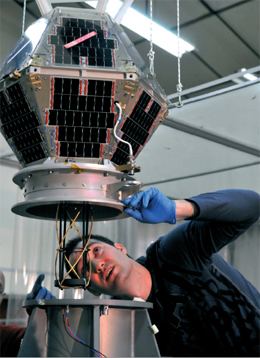Mission type Communication COSPAR ID 2009-041E Bus Nanosat-01 Inclination 98.1° Launch date 29 July 2009 | Operator INTA SATCAT no. 35685 Inclination 98.1° Period 1.6 hours | |
 | ||
Manufacturer Universidad de SevillaUniversitat Politècnica de CatalunyaAD TelecomUniversidad Complutense de Madrid Similar UK‑DMC 2, Progress M‑66, Progress M‑MIM2, Universitetsky‑Tatyana‑2, PharmaSat | ||
The Nanosat-1B Spanish satellite, designed, developed and operated by the Instituto Nacional de Técnica Aeroespacial (National Institute of Aerospace Technology), INTA, is a nano-satellite which weighs 22 kg. Its main mission is the communication between remote sites like the Antarctic, the Hespérides warship and Spain. The Nanosat-1B has fourteen sides, all of them covered by solar panels but the bottom one where the following antennas are installed: a medium gain UHF four wire antenna and two patch antennas. On the top side there are four UHF monopoles. The solar sensors and the Vectorsol experiment are located in the middle tray, being all the other equipment and experiments located inside the satellite.
Contents
The Nanosat-1B covers all the earth due to his polar orbit and it stores scientific data which are unloaded when the satellite passes the Control Centre vertical (located at INTA, Torrejón, Madrid) and the mobile stations (Nano-Terminals).
This satellite was launched on 29Th of July 2009 at 18:46 h. UTC from de “Cosmodromo” in Baikonur (Kazajistan), launch pad 95 area 109, by a Dnepr rocket along with other five satellites : the DubaiSat-1 (this one being the main load), Deimos-1, UK-DMC 2, Aprizesat-3 and Aprizesat-4.
NANOSAT-1B Payload
Three Experiments:
Two Communication Systems:
Future approach
Besides their weight and size characteristics, the Nano-satellites are a new concept of design for space system and a great opportunity to reach space at lower development cost and time. The Nanosat Program foresees several new launches with precise applications, as these platforms are particularly suitable for in orbit demonstration missions including instruments, components and supporting technologies for bigger Space Programs.
